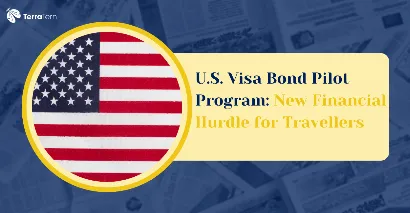Key Highlights
Places where people collectively gather to execute business or social activities, also known as tourist attractions, have been happening in the United States, which continues to get millions of visitors on an annual basis. Nonetheless, a recent piece of policy presented by the U.S. Department of State will impose a huge financial burden on some travellers. In late August, some visa applicants will have to hand in a bond of up to $15,000, which is refundable under a new pilot programme. The purpose of the action, mainly, is to lower the level of visa overstays, yet the shift may have impressive consequences for international travel, business, and even diplomacy.
The new regulation that affects those countries where the visa overstays are high and the screening mechanisms are not so strong is expected to ensure that the visitors leave their native countries on schedule. Although the policy is currently in a pilot stage, it has already attracted issues among those who may be affected by the policy, businesspeople, and those concerned about immigration issues. The economic need for a bond with restrictions on travel might reinvent the scenery of foreign visits to the U.S. and pose unexpected difficulties for visitors to gain entry into the country.
Also Read: U.S. Launches Jobs and Internships Platform for Indians
Understanding the New Visa Bond Program
The Department of State is not introducing a universal policy as part of the pilot programme; the measure is selective. It concerns a specific group of countries where the visa overstay rate is the central issue for the U.S. authorities. The most obvious of these purposes is the notion that it offers an incentive of a financial sort, which would compel the tourist to adhere to the stipulations of his visa and leave the country prior to the expiration of the specified time he is allowed to stay in that country. The bond, culminating in up to 15,000 dollars, acts as a type of deposit. This is a huge amount of money that is retained by the government of the U.S. and can only be refunded after the traveller has made necessary documentation to ensure that he or she has departed the United States on time.
This policy is an extreme change in strategies to handle visa compliance that have been in use. The government is prioritising the use of a direct financial mechanism instead of using enforcement and future travel prohibitions using visas as the only tool. This programme will be for 12 months, and within that period, the Department of State will evaluate the programme on whether it is effective or not. The outcomes of this pilot will either lead to expansion, modification, or discontinuation of this policy.
Who Is Affected by This New Policy?
The pilot programme does not apply across the board to international travel. The Department of State has so far set aside certain countries that will be affected by this new visa bond requirement for their nationals. The other two named nations are Zambia and Malawi. These nations were chosen based on different data touching upon visa overstay rates. This selective strategy implies that the government of the United States is working where it considers non-compliance to be most critical. The choice of these countries, and possibly some other ones in the future, is one of the most important elements of the programme since it determines the scale and influence of the new rules.
Although currently the attention is focused on these two countries, the policy framework still allows introducing other states into this list. This brings a form of uncertainty to the tourists of other nations who may fear future changes in policy. The conditions imposed by the government that warrant the removal or inclusion of a country in the programme are based on the overstay statistics and other screening data. Thus, the scope of the policy may grow, and a greater number of foreign visitors will be impacted during the next several months.
The New Rules and Their Impact on Travel
In addition to the fact that the bond is a major financial burden, the new pilot programme offers other strict limitations to travellers who will be affected by it. These regulations are aimed at making the travel experience more disciplined and restricted, with not much space to explore the proposed objective of the visit. The financial bond, together with these new harassing measures of travel, becomes a multi-dimensional problem for the individuals who want to enter the United States.
The visa bond has successfully changed the conditions of a regular tourist or business visa. Such modifications are supposed to introduce more oversight and control; nevertheless, they diminish considerably the amount of freedom and comfort travellers have had in the past to a considerable degree. To the people who depend on tourism or travelling to the U.S. on business, such regulations may result in an impossibly expensive or incredibly complex process.
Also Read: US Visitor Visa B1/B2
Strict Visa and Entry Requirements
There are several restrictions that passengers affected by this new policy will have to contend with. The first is a very limited period of validity of its visa. These visitors will be given a single-entry visa with a validity of three months as opposed to the normal multiple-entry tourist visa that is valid for up to several years. This implies that they will not be able to re-enter the U.S. within this time without a new application for a visa.
Also, they will only stay 30 days. This is a considerable drop as opposed to the usual six months given to B-1 (business) and B-2 (tourist) visa holders. A 30-day limit may pose as a huge restriction to people who are having a lengthy business mission or are on a personal holiday. The last limitation would be related to the port of entry. They will be limited to three particular airports to travel to: Boston Logan International Airport, John F. Kennedy International Airport and Washington Dulles International Airport. It makes travellers change their routes to these definite destinations, which might not be the most convenient or economic courses.
Economic and Social Repercussions
It is believed that the introduction of the visa bond programme can produce a ripple effect in different sectors. The tourism industry will be affected the most. A bond ranging up to 15,000 dollars is quite a sum of money and is refundable at that – a sum that is too big for most tourists. This poses a serious economic challenge that will more likely induce a decline in tourism in affected nations. It could, in turn, affect such businesses that are dependent on the flow of international tourists, like hotels, airlines, and other local attractions.
At a larger level, this policy might have economic and diplomatic consequences for world trade. Firms that have operations or affiliations in the victimised nations might be more challenged to invite their staff out to attend training, meetings or conferences. The new administrative burdens may pose demands on HR departments and international business relationships. The consular relations might be even challenged since the policy might be seen as another form of discrimination against the citizens of a particular country, which may result in harmful retaliation or a rupture in relationships.
Also Read: How Many Types of Visas in the USA? New Full Expert Guide
A Closer Look at the Pilot Program's Future
The pilot period of 12 months is meant to be an observation period. The U.S. government will be closely tracing the efficiency of the program in terms of lowering the rate of overstays using visas. Provided that the program turns out to be successful, there is a great likelihood that it might be extended to incorporate other countries as well. Another influential element is the legal and political environment that is associated with the present policy. It is expected that legal challenges by different organisations will be levelled against the program, and this may jeopardise its sustainability. The ultimate impact of the program can only be determined with a keen observation of how well the program achieved its objectives, the economic and social contribution of the program, and the legal decisions that can be made concerning the program.
To stay updated about the latest immigration news, contact TerraTern right away!








